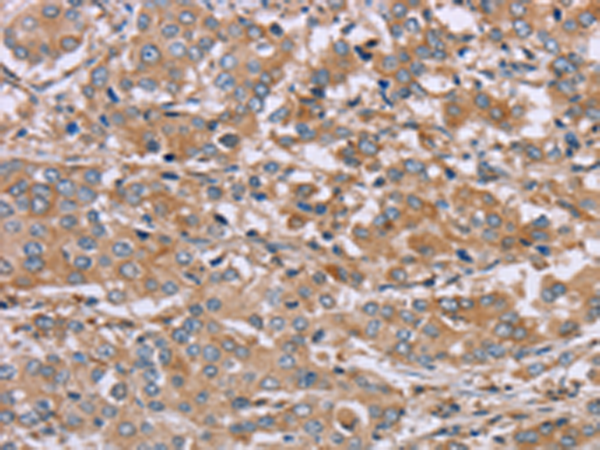

| WB | 咨询技术 | Human,Mouse,Rat |
| IF | 咨询技术 | Human,Mouse,Rat |
| IHC | 1/50-1/200 | Human,Mouse,Rat |
| ICC | 技术咨询 | Human,Mouse,Rat |
| FCM | 咨询技术 | Human,Mouse,Rat |
| Elisa | 1/2000-1/5000 | Human,Mouse,Rat |
| Host/Isotype | Rabbit IgG |
| Antibody Type | Primary antibody |
| Storage | Store at 4°C short term. Aliquot and store at -20°C long term. Avoid freeze/thaw cycles. |
| Species Reactivity | Human, Mouse, Rat |
| Immunogen | Synthetic peptide of human NDRG3 |
| Formulation | Purified antibody in PBS with 0.05% sodium azide and 50% glycerol. |
+ +
以下是关于NDRG3抗体的3篇参考文献的简要列举:
1. **"NDRG3 is essential for hypoxia-induced mitochondrial homeostasis and tumor progression"**
- **作者**: Lee YJ, et al.
- **摘要**: 该研究通过NDRG3抗体进行Western blot和免疫荧光实验,发现NDRG3在缺氧条件下调控线粒体功能,促进肿瘤细胞存活和转移,揭示了其在癌症进展中的关键作用。
2. **"The role of NDRG3 in the regulation of prostate cancer cell proliferation"**
- **作者**: Liu W, et al.
- **摘要**: 利用NDRG3抗体进行免疫组化分析,发现NDRG3在前列腺癌组织中高表达,并通过抑制细胞周期蛋白抑制肿瘤细胞增殖,提示其作为潜在治疗靶点。
3. **"NDRG3 modulates vascular endothelial growth factor receptor 2 signaling in angiogenesis"**
- **作者**: Park SY, et al.
- **摘要**: 研究通过NDRG3抗体检测内皮细胞中的蛋白表达,证明NDRG3通过调节VEGFR2信号通路影响血管生成,为抗血管治疗提供了新方向。
以上文献均通过NDRG3抗体在实验中验证蛋白表达或功能,涵盖癌症、血管生成等研究领域。
The NDRG3 (N-Myc downstream-regulated gene 3) antibody is a research tool used to detect and study the NDRG3 protein, a member of the NDRG family implicated in cellular stress responses, differentiation, and cancer biology. NDRG3. encoded by the *NDRG3* gene, is regulated by hypoxia, steroid hormones, and oncogenic signaling pathways. It shares structural homology with other NDRG family members but exhibits distinct tissue-specific expression, notably in the brain, prostate, and reproductive organs.
Functionally, NDRG3 is linked to cell proliferation, apoptosis, and metastasis. It interacts with signaling molecules like HIF-1α under hypoxic conditions, potentially modulating tumor angiogenesis and progression. Dysregulation of NDRG3 has been observed in cancers such as prostate, liver, and glioblastoma, suggesting roles as either an oncogene or tumor suppressor depending on context.
NDRG3 antibodies are typically developed in hosts like rabbits or mice, targeting specific epitopes (e.g., C-terminal regions) for applications such as Western blotting, immunohistochemistry, and immunofluorescence. Their specificity is critical for distinguishing NDRG3 from homologous proteins (e.g., NDRG1/2/4). Researchers utilize these antibodies to explore NDRG3's molecular mechanisms, including its phosphorylation states, subcellular localization, and interactions with pathways like PI3K/AKT or RAS-MAPK. Validation via knockout controls or siRNA knockdown ensures reliability. Ongoing studies aim to clarify its dual roles in cancer and its potential as a therapeutic target or biomarker.
×